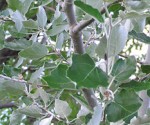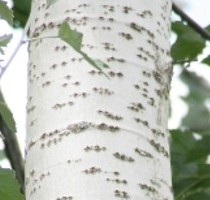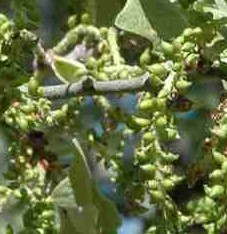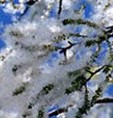 White poplar is a suckering deciduous tree native to moist areas in Europe and central Asia but widely planted throughout the US where it naturalized and is especially prevalent in the East. It is a member of the willow family (Salicaceae) that also includes aspen and cottonwood. With a wide-spreading, open canopy, the tree has grayish white bark and greenish white branches with white wooly twigs and buds. The bark darkens with maturity and becomes fissured. The leaves have wavy margins and three to five lobes, and are toothed and two to six inches long by 1.5 to 3.5 inches wide. They are dark green above and covered by white wooly hairs beneath so give a shimmering effect in a breeze. In spring red male flowers and grayish green female flowers appear in catkins two to three inches long on different trees before the leaves emerge. Female flowers elongate after pollination and give way to small capsules that open in late spring to early summer and contain numerous tufted seeds. White popular is an adaptable tree and good for such uses as erosion control and windscreens but because the roots are shallow, spreading, and invasive, the trees should be grown far from sewer lines, drains, sidewalks, and pavements. In addition, strong winds may topple the trees and/or break branches, and abundant seed production and suckering may allow white poplar to crowd out native species. The genus name, Populus, is the Latin word meaning people and may refer to the use of some members of the genus in public places. The specific epithet, alba, is the Latin word meaning white and refers to the grayish white bark.
White poplar is a suckering deciduous tree native to moist areas in Europe and central Asia but widely planted throughout the US where it naturalized and is especially prevalent in the East. It is a member of the willow family (Salicaceae) that also includes aspen and cottonwood. With a wide-spreading, open canopy, the tree has grayish white bark and greenish white branches with white wooly twigs and buds. The bark darkens with maturity and becomes fissured. The leaves have wavy margins and three to five lobes, and are toothed and two to six inches long by 1.5 to 3.5 inches wide. They are dark green above and covered by white wooly hairs beneath so give a shimmering effect in a breeze. In spring red male flowers and grayish green female flowers appear in catkins two to three inches long on different trees before the leaves emerge. Female flowers elongate after pollination and give way to small capsules that open in late spring to early summer and contain numerous tufted seeds. White popular is an adaptable tree and good for such uses as erosion control and windscreens but because the roots are shallow, spreading, and invasive, the trees should be grown far from sewer lines, drains, sidewalks, and pavements. In addition, strong winds may topple the trees and/or break branches, and abundant seed production and suckering may allow white poplar to crowd out native species. The genus name, Populus, is the Latin word meaning people and may refer to the use of some members of the genus in public places. The specific epithet, alba, is the Latin word meaning white and refers to the grayish white bark.
 Type: Deciduous tree
Type: Deciduous tree
Outstanding Feature: Leaves, bark
Form: Irregular open canopy
Growth Rate: Rapid

Bloom: Red male flowers and grayish green female flowers in catkins two to three inches long on different trees before the leaves emerge in spring
Size: 40-75’ H x 40-75’ w
Light: Full sun; tolerates some shade
Soil: Average, medium moist, well-drained; tolerates wet soils and some drought
Hardiness: Zones 3-8

Care: Pruning when young is necessary to encourage a pleasing shape; prune high in fall. Tree can take heavy pruning.
Pests and Diseases: Leaf hoppers, thrips, borers, aphids, caterpillars, scale, dieback, canker, rust, powdery mildew
Propagation: Very fresh seed, division of suckers, hardwood cuttings
Comments: All-male trees and columnar varieties available.